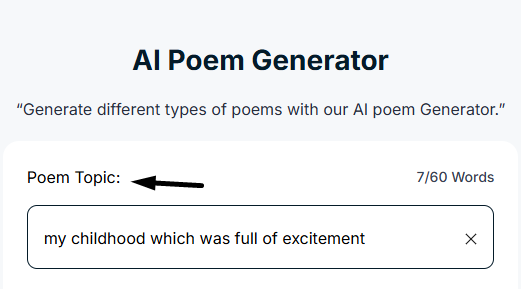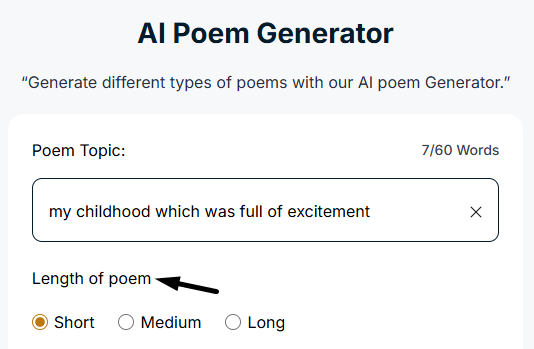

"Words weave worlds beyond the page,
Ink spills thoughts both bold and sage.
A dance of rhythm, sound, and grace,
Each line a mirror; time can’t erase.
Writing lives where voices fade."
We wrote this poem in under an hour. And you can do the same (perhaps in less time). But that requires understanding and practice - understanding of the poem’s elements and practice of reading and writing poetry consistently.
And that’s exactly what this article entails - how to write a good poem. We will discuss the main elements of the poem before diving into the step-by-step process of writing a poem. So, let’s rhyme in.
Now, that’s a hard definition to crack because there’s no right or wrong answer to it. At its core, it’s a special way of using words to express emotions or tell a story in a rhythmic way. Poets may use figurative language, similes, metaphors, or rhyme schemes to paint a picture in the eyes of the readers.
That being said, here are 3 definitions of a poem by famous poets.
Before we expand on how to write a good poem, you should first understand the 3 main elements of a poem, that are rhythm, format, and literary devices. Let’s break down each of these for you.
Rhythm is the heartbeat of poetry. It gives a poem its movement and makes it engaging to read. Broken down into sound, meter, and rhyme, rhythm is what brings a natural flow to the words, just like a song.
Some poems have a steady beat, while others are free-flowing. It is created by stressed and unstressed syllables in a line or verse.
Poetry is meant to be read as well as heard. This is where sound comes in. The way words sound together can create harmony, tension, or emphasi,s and this dictates how it will feel to the listener. Poets choose words to create certain sound effects that reinforce meaning and enhance the rhythm.
Consider this short verse:
"Soft seas sigh and sliver sands gleam,
Moonlight whispers in a twilight dream."
Here, the repetition of the word ‘s’ sound mimics the gentle lapping of waves, making the lines feel smooth and calming.
Poets use techniques like alliteration (repeated constant sounds), assonance (repeated vowel sounds), and consonance (repeated consonant sounds within words) to craft soundscapes within their poetry.
Meter is the flow of unstressed (‘) and unstressed (‘’) syllables in a poem. Just like music has tempo, poetry has meter to give it flow and beat. It helps set the mood — steady and formal or slow and reflective.
For example, in Shakespeare’s famous line from Romeo and Juliet:
“But soft! What light through yonder window breaks?”
This follows iambic pentameter, a meter where each line has five pairs of alternating stressed and unstressed syllables. Common meters include:
It’s the repetition of similar sounds, usually at the end of lines. Some poets use perfect rhymes like love-dove while others use slant rhymes like prove-love for a subtler effect. Let’s have a look at this example from Robert Frost’s “Stopping by Woods on a Snowy Evening:”
“He will not see me stopping here
To watch his woods fill up with snow.
My little horse must think it queer
To stop without a farmhouse near.”
Here, the words “here” “queer” and “near” rhyme to create a flowing rhythm.
In writing poetry, format is the structure that shapes a poem’s rhythm and meaning.
Where prose has sentences and paragraphs, poetry has stanza structures, line breaks, and patterns. This way, an artistic expression is created.
For example, a quatrain (a four-line stanza) usually adopts an ABAB or AABB rhyme, which makes it easy to memorize (will be discussed below).
A poem is more than just sentences on a page. Literary devices add depth, beauty, and meaning to a poem. Some of the most common ones are:
Now that you’ve understood the elements (which was integral), let’s jump into the step-by-step guide to writing poetry. We will discuss this in 7 steps. Now, every poet or writer will have a different process and number of steps, and we completely understand that.
One may start with step 3, while the other may skip step 7 completely. Nonetheless, the steps mentioned here follow a logical flow to help you shape your poem from start to finish.
Every poem starts with a spark, i.e., an idea or emotion that inspires the poet to build words around. It can come from anywhere: personal experience, nature, a conversation you remember, a piece of art, or even a random thought you had on the train. The key is to stay observant of the world around you.
If you’re unsure where to start or don’t have a topic, try these methods:
Once you have inspiration, the next step is to choose a theme. It’s the central idea or emotion your poem will explore. Themes in poetry can be broad. Think love, nature, loss, hope, or a moment of self-discovery. For example, Robert Frost’s “The Road Not Taken” revolves around the theme of choice:
"Two roads diverged in a wood, and I
I took the one less traveled by,
And that has made all the difference."
To develop a unique poetic voice, focus on themes that resonate with you. Ask yourself questions like “What emotions do I want my readers to feel?” or “What personal experience can I draw from?”
Once your theme is clear, you’re ready to choose from different types of poems. In poetry writing, form is just as important as content; it dictates the rhythm, flow, and emotional impact of your poem. They range from structured formats like sonnets and haikus to free verse, where rules are flexible.
To see how form shapes meaning, here’s an example of the same idea written in two different styles:
Limerick:
“A poet once sat in the shade,
Where verses and rhymes he had made.
His thoughts danced around,
In rhythm profound,
Till ink on the paper has stayed.”
Couplet:
“A poet sat beneath a tree,
His words as wild as the rolling sea.”
Both convey the same idea — about a poet composing under a tree- but the limerick creates a playful, sing-song effect, while the couplet feels more lyrical and refined.
It’s now time to bring your poem to life with imagery and language. Great poetry doesn’t just tell; it shows, making readers see, hear, and feel the emotions behind the words.
What is imagery? Well, it’s the use of descriptive language that appeals to the senses. For example, instead of saying, “The sun was bright,” you could write:
“Golden rives of light spilled across the morning sky,
Warming the earth with whispers of fire and gold.”
And how about playing around with stanza structures? A short stanza can create urgency, while a longer one can feel more reflective. Let’s look at this example for better understanding:
Short stanza:
“The storm screams,
Clouds collide,
Thunder breaks the sky apart.”
Long stanza:
“The storm rolled in, a beast untamed,
A symphony of thunder framed,
By jagged streaks of silver light,
That danced across the sky that night.”
The next step in writing a poem correctly is the integration of literary devices. This includes everything we discussed above, i.e., metaphors and similes, figurative language, puns, hyperbole, symbolism, and personification.
We already discussed some of the literary devices above. A few other examples are shown below:
The right literacy device can make your poem resonate with readers long after they’ve finished reading it.
Rhyme and meter shape how a poem sounds when read aloud. They control the pacing, mood, and musicality of your words. You have to choose the schemes that suit you the most and will be more understood by your audience, but here are 2 examples of different rhyme schemes that are popularly used.
AABB: The first 2 lines rhyme, and the next 2 do as well.
“The stars shine bright (A)
They light the night (A)
The wind so free (B)
It sings to me (B)”
ABAB: Alternating lines rhyme.
“The river flows with silver light (A)
The birds above begin to sing (B)
The moon emerges, shining bright (A)
The gentle breeze begins to cling (B).”
Did you notice the musicality in these? We bet you’re thinking about all those song lyrics you play on repeat. Yeah? A big part of why they get stuck in your mind is these rhyme structures.
Just like any other piece of writing (even this article we’re writing:p), the poem needs refinement to ensure clarity, rhythm, and emotional impact. any quick editing tips?
In this modern era, we can’t leave AI, right? It’s a tool that has and will make our lives better. But can it help you to write better poems as well? Or at least give you the inspiration you need in the case of writer’s block?
Yes, tools like our AI Poem Generator can surely save the day for you. The process?

2. Select the length of the poem you want to create. You can choose from Short, Medium, or Long.

3. Now, select the poem format you wish for. There are 10 forms, including Acrostic, Epitaph, and Sonnet, to name a few.

4. Click Generate Poem to get the desired poem within a few seconds.

5. You can click Regenerate for a different output as well.

Mastering how to write a poem is about balancing creativity with structure. From finding inspiration to adding imagery and literary devices (which we discussed in the article), each step shapes your poetic voice.
With practice and passion, you will be able to craft words that move feelings and tell stories people love.
How do I structure my poem?
A poem’s structure depends on stanza length, rhyme scheme, and rhythm. You can follow traditional forms like sonnets, haiku,s or free verse, or create your own. Make sure to maintain consistent stanza structures, line breaks, and literary devices to enhance the flow and meaning of your poem, though.
How many lines are in a stanza?
A stanza can have any number of lines. It depends on the poem’s form and the poet’s intent. Common stanza types include:
What is a line break in a poem?
A line break is where a poet ends one line and starts another. It controls the rhythm, pacing, and emphasis of the poem. Poets use them to create pauses, shift meaning or enhance imagery. In free verse, line breaks replace punctuation for dramatic effect, while in structured poetry, they follow a set of rhythm.